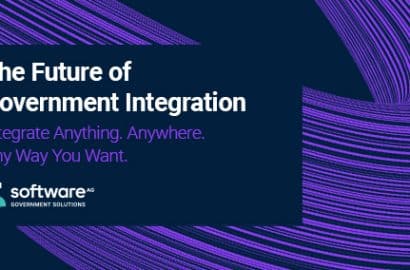Driving Mission Impact – Integrating Anything. Anywhere. Any Way You Want.

Last fall, Software AG Government Solutions introduced a groundbreaking solution called ‘Super iPaaS,’ a new kind of integration platform designed to support the modernization of government IT systems.
Super iPaaS serves as a unified, user-friendly interface catering to all integration requirements. It grants users complete command over diverse IT landscapes, spanning from on-site systems to the expansive cloud environment. Moreover, Super iPaaS places paramount importance on API management and implements robust security measures to ensure data remains safeguarded.
In December, Subhash Ramachandran, Senior Vice President, Product Management at Software AG, gave a presentation at the ATARC 2023 CIO Summit titled, “Driving Mission Impact: Integrating Anything. Anywhere. Any Way You Want.” The presentation provided a deep-dive perspective on the value of Super IPaaS for leveraging data at mission speed for government.
We recently sat down with Subhash to discuss what he covered in his presentation, as well as gain his perspective into how government agencies can unlock the true potential of legacy data.
Q: Please tell us about what you covered in your presentation at ATARC 2023 CIO Summit.
Subhash: The focus of the presentation centered on Software AG’s new approach to integration, which we are calling Super iPaaS. The starting point of the discussion was to address prevalent application and data integration issues in government – notably the increasing number of applications and data sets contributing to what we term the ‘chaos of connectivity.’
I also referenced surveys conducted by the Government Accountability Office (GAO) highlighting the persistence of legacy systems and the substantial ongoing expenditure on them.
Throughout the event, the recurring theme was IT modernization, although the reality remains that numerous legacy applications within government agencies will not undergo this process. Consequently, the need to integrate and access valuable data stored in these systems persists today.
After highlighting these key challenges, I introduced the concept of Super iPaaS, presenting it as an innovative approach to integration. This multifaceted solution is capable of addressing various integration use cases such as applications, data, B2B interactions, files, APIs, and events. This dual perspective illustrates one aspect of Super iPaaS. The other viewpoint focuses on its overarching benefits, encompassing non-functional aspects like governance, agility, and productivity.
Finally, I concluded by highlighting various federal, state, and local agencies utilizing Software AG’s Super iPaaS technology. These agencies employ the technology to enhance customer experience, streamline citizen services, and facilitate integration among different governmental bodies.
Q: Please tell us a bit more about the persistent, legacy data that’s holding back agencies.
Subhash: Before diving into the persistent legacy data challenge, I wanted to highlight some very interesting discussions during the AI panel that preceded my presentation.
The panel comprised five or six CIOs from different government agencies. Despite the panel’s focus on AI, each participant, when introducing themselves, highlighted a common concern: data silos. They articulated challenges around accessing data dispersed across numerous applications they managed. Interestingly, their insights perfectly aligned with the problem statement I later presented regarding the chaos of connectivity.
It struck me that their remarks were inadvertently advocating for Software AG’s solutions. Repeatedly, they emphasized the ongoing issue of legacy systems, stressing the necessity of consolidating these applications. They emphasized the critical role of amassing substantial data for AI utilization, aptly referring to it as ‘feeding the AI monster.’ This process involves aggregating vast amounts of data to train models and subsequently derive insights.
The initial step crucially revolves around data access. Without integration, obtaining this data becomes unattainable. Notably, the landscape isn’t solely comprised of SaaS and open cloud platforms; legacy applications with their distinct proprietary interfaces also play a pivotal role.
Therefore, any integration technology must adeptly navigate various interfaces, including open APIs, proprietary APIs, and diverse protocols and technologies to effectively access and utilize this data. Whether for AI utilization, interagency data sharing, or mobile app development, the core issue lies in overcoming the barriers posed by data silos.
This was corroborated by insights from the panel of five or six CIOs, highlighting the prevailing data silos within their respective agencies.
Q: Overall, how is Super iPaaS poised to help bring overall government IT modernization efforts to life?
Subhash: A critical aspect that distinguishes Software AG’s Super iPaaS is its consolidation of application and data integration. Traditionally, these functions have resided within separate silos, even within the confines of IT, whether in government agencies or commercial organizations.
Historically, application integration has been aligned with specific groups managing applications, such as major ERP vendors like SAP, Oracle, and, more recently, Salesforce. On the other hand, data integration technologies have typically been associated with Business Intelligence (BI) and analytics teams, increasingly extending to cloud data platforms such as Snowflake.
Traditionally, the division between application and data integration in organizations hindered the realization of synergies and combined benefits. This is precisely where Super iPaaS steps in.
While our platform encompasses multiple facets of integration, I’m specifically emphasizing the convergence of application and data integration. This union facilitates several advantages. First, it dismantles barriers within agencies regarding data movement – be it for application synchronization or driving analytics.
Although these objectives may seem distinct, in today’s context, the necessity for real-time information makes them interconnected and crucial. Super iPaaS excels in breaking down these data silos, a fundamental aspect of IT modernization. Rather than replacing legacy systems, it creates an overlay to unlock data trapped within these silos.
Second, by unifying the app and data integration functions, the platform encourages collaboration among teams that previously operated in separate silos. This convergence not only breaks down data silos but also organizational barriers, aligning diverse teams toward a unified vision encapsulated by Super iPaaS.
Q: Can you share some government agency outcomes and successes around Super iPaaS?
Subhash: Software AG’s Super iPaaS solution has significantly benefited numerous government agencies, spanning federal, civilian, DoD, and state and local sectors.
For example, at the Social Security Administration (SSA), our solution successfully dismantled data silos and liberated legacy data. Specifically, we’ve effectively unlocked data entrenched in mainframes and green screens, harnessing our API integration layer to establish a cohesive and secure platform. This unified platform offers scalable solutions to end-users, including Social Security recipients. At the SSA, we’ve developed over 500 APIs on our platform, facilitating a staggering 8 billion API transactions annually. This serves as a compelling illustration of our solution’s impact.
Another example is the Internal Revenue Service (IRS). Over the past few years, the IRS has undertaken an ambitious initiative to modernize the tax filing process through their E-filing services. This endeavor has significantly assisted citizens by offering diverse E-filing methods, many of which utilize the Super iPaaS platform via our APIs and integrations with various external partners and agencies. For the IRS, we streamlined their architecture, establishing an extensive enterprise-wide infrastructure grounded in our API and integration layer. This infrastructure greatly simplifies the electronic tax filing process and affords the IRS a comprehensive overview of filings from across the nation.
Another notable example is the Pennsylvania Justice Network (PA JNET) in the state and local arena. Our work with PA JNET has significantly enhanced information sharing among various agencies in Pennsylvania and extended to other states across the U.S. This collaborative effort has contributed to bolstering public safety measures, reducing crime rates, and notably, yielding substantial benefits, including approximately $200 million in fraud prevention. These achievements stem from the integrated technologies we’ve implemented within the network.
The final example highlights a significant transformation in the military’s supply chain, particularly within the Department of Defense (DoD) and Navy ERP. Our Super iPaaS solution has modernized the entire supply chain by integrating finance and over 70 DoD applications.
Presently, more than 50 percent of these operations are seamlessly handled through the Super iPaaS platform. This enhancement has improved reliability, security, and scalability while achieving substantial benefits. It has also led to an annual reduction of over $100 million in inventory management costs. These instances collectively showcase the impact and versatility of our solutions across various domains.
Q: What is your take on the impact of Super iPaaS for the future of government?
Subhash: The key challenge faced by government entities revolves around making informed decisions based on real-time and pertinent information. Our consistent focus has been on highlighting the ‘chaos of connectivity,’ wherein data is segregated across numerous silos.
At Software AG, our goal is to lead the IT modernization efforts of government agencies. While these agencies are actively involved in various IT modernization endeavors – an admirable effort – our ambition is to contribute to the comprehensive modernization of the entire government landscape by prioritizing integration.
Integration often isn’t perceived as a top priority, as agencies tend to predominantly emphasize applications, rightly considering them as the cornerstone of IT. However, a gradual realization – seen earlier in commercial organizations during their digital transformation journeys – is now echoing within government. Initiatives such as AI are truly advancing government digital transformation efforts.
While this is just one example among many illustrating the necessity of digital transformation, it underscores a critical realization: in digital transformation, the emphasis shifts from applications to integration.
Integration is critical because it grants access to vital data. Prevailing IT architectures have often established an abstraction layer, enabling real-time access to information rather than relying on batch modes or dated data. Super iPaaS embodies this concept, positioning integration as the paramount discipline, thereby urging a shift in priorities.
Elevating integration to a top-tier priority underscores its urgency, prompting investments and laying the foundation for realizing the value of initiatives like AI, a domain where the government is keen on leveraging technology to enhance the lives of its citizens.
We would like to thank Subhash for sharing his insights with us! Contact Software AG Government Solutions to learn more about how Super iPaaS can revolutionize your agency’s IT infrastructure.
Want to keep up with all things Software AG Government Solutions?
Share your email address below.

View our upcoming events and on-demand webinars







